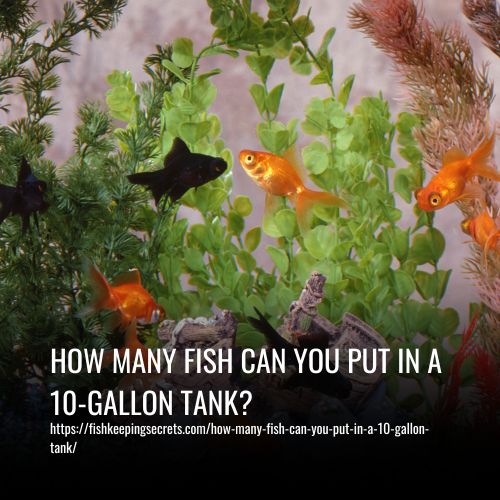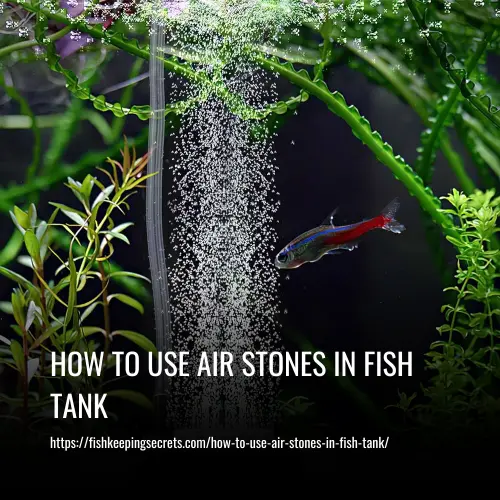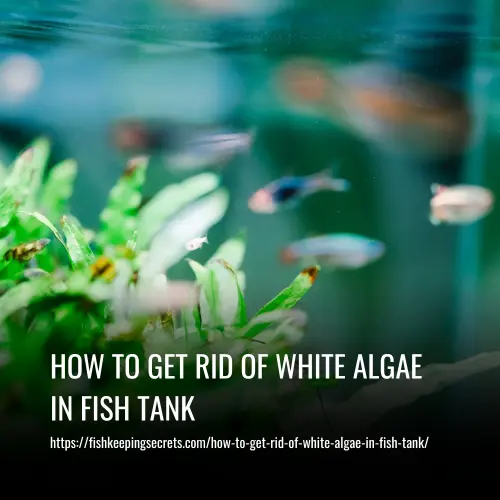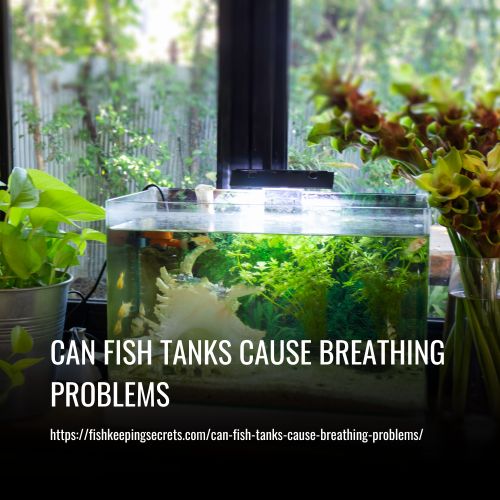The number of fish you can put in a 10-gallon tank depends on several factors, including the size of the fish and their water requirements. On average, it is recommended to have about 5-10 fish in a 10-gallon tank. However, it’s important to consider the growth rate of the fish species you have chosen.
If they are fast-growing, it is best to limit the number to around 6 or 8 to prevent overcrowding and ensure the well-being of the fish. Additionally, it’s essential to regularly monitor water quality and provide proper filtration and maintenance to keep the tank environment healthy for your fish.

How to Decide On the Amount of Fish to Keep in a 10 Gallon Tank
Deciding on the number of fish to keep in a 10-gallon tank requires careful consideration of various factors. While there is no definitive answer, the following guidelines can help you make an informed decision:
1. Fish Size
Consider the adult size of the fish you plan to keep. Small fish species, such as guppies or neon tetras, require less space and can be kept in larger numbers. Larger fish, such as angelfish or gouramis, will need more space and should be kept in smaller numbers or in larger tanks.
2. Dietary Needs
Different fish species have different dietary requirements. Some fish may be herbivores and can survive on a vegetarian diet, while others may require regular feedings of live or frozen food. Consider the feeding habits of the fish you plan to keep and ensure you can provide a suitable diet for them.
3. Tankmates
Take into account the compatibility of the fish species you plan to keep. Some fish are aggressive or territorial and may require more space or specific tank setups. Research the compatibility of different fish species to ensure they can coexist peacefully in a 10-gallon tank.
4. Care Requirements
Certain fish species have more complex care requirements and may require more attention and maintenance. Exotic or sensitive fish species may need specific water parameters, feeding regimes, or tank setups. Be prepared to invest the time and effort required to meet these needs.
5. Personal Preferences
Ultimately, your own preferences and goals for the tank should also be considered. If you prefer a tank with a larger number of smaller fish, you may need to choose species accordingly. If you prefer a tank with fewer, larger fish, select species that are compatible with this setup.
Remember, overcrowding a tank can lead to stress, poor water quality, and health issues for the fish. It is always best to err on the side of caution and provide ample space for your fish to thrive. Regular monitoring of water parameters and behavior of the fish will help you determine if any adjustments need to be made.
What Fish Do Well In A 10-Gallon Tank
If you have a 10-gallon tank, there are several fish options that can thrive in this size tank:
1. Guppies
Guppies are beginner-friendly fish that are easy to care for and can be bred without additional assistance. It’s best to have either females or males in the tank without mixing them. You can have five to 10 guppies in a 10-gallon tank, but if you’re setting up a breeding tank, use the ratio of one male to two females and have another tank for transferring the fry.
2. Neon Tetras
Neon Tetras are schooling fish that prefer to be with more of their kind. They are peaceful and grow to about 1.25 inches long. You can fit around 10 Neon Tetras in a 10-gallon tank. Make sure not to overcrowd them and maintain pristine water conditions. Provide plenty of plants, rocks, and driftwood for them to hide, as they prefer a well-decorated tank.
3. Glofish
Glofish are colorful schooling fish that come in different species like Tetras, Danios, Tiger Barbs, and Rainbow Sharks. It’s important not to overcrowd a 10-gallon tank with decorations when keeping Glofish. A single school of Tetra or Danio species, consisting of about 5-6 fish, is ideal for this tank size. Tiger Barbs and Rainbow Sharks, being slightly aggressive, are not recommended for a 10-gallon tank.
4. Goldfish
While goldfish are popular pets, a 10-gallon tank is not suitable for them, especially as they grow larger. If you want to stock juvenile goldfish or fry, you can keep 3-5 fish in this tank size. However, adult goldfish will require at least a 20-gallon tank to swim comfortably.
5. Mollies
Mollies are active swimmers that require more space than a 10-gallon tank can provide. While the minimum recommended tank size for mollies is 10 gallons, it can only hold 2 mollies. If you plan to add more mollies, you will need to upgrade to a larger tank, preferably 20-30 gallons.
Remember to research each species’ specific care requirements and ensure that the tank is properly cycled and maintained to create a healthy and suitable environment for the fish.
Will Fish Do Well In a 10-Gallon Tank
The best kind of tank for your fishy friends depends on their species and how many little ones you bring home – will a 10-gallon fit the bill? For instance, a school of 6 ember tetras is usually a safe bet in an aquarium like this, however, if you’ve got 30 of them swimming around then it’s definitely going to be too crowded.
Likewise, bettas are great companions for tanks of this size, but you wouldn’t want to put a single goldfish in there as it won’t have enough space! It’s important to pick your tank inhabitants carefully so that they can all thrive and live happily in the environment you give them.
What Is the Biggest Fish You Can Keep In a 10-Gallon Tank
If you’re looking for the largest fish to keep in your 10-gallon tank, look no further. Betta fish and dwarf gouramis are two contenders for the title of biggest fish that can fit in that size of the tank. Bettas are huge in popularity due to their vibrant colors and hardy nature, while dwarf gouramis provide a bit more diversity with both males and females reaching up to approximately 2.5 inches in length.
Female dwarf gouramis have the potential to grow up to three inches in length so make sure you leave enough space in the aquarium if you’re considering this particular breed. Whether you opt for a betta or a dwarf gourami, they make great inhabitants for any 10-gallon tank so it’s all down to personal preference.
Tips for Maintaining a 10-Gallon Tank
Having a 10-Gallon tank comes with its own set of rewards, but it also has its fair share of challenges when it comes to maintenance. The best way to keep your 10-Gallon tank in good shape is to make sure you change out 30% of the water every week. This will ensure that the fish has good water quality and remain healthy. You should also be sure to install a filtration system which will help keep oxygen levels up, preventing any leftovers from accumulating in the tank.
When it comes to overcrowding, less is always more; too many fish can easily lead to poor water quality due to increased amounts of waste products. It’s very important not to overfeed the fish either, as this could potentially release contamination byproducts into the water column as well.
To avoid unhealthy levels for your fish, use an API ammonia test kit from Amazon to check for ammonia or nitrite buildup that may occur over time. Following these steps will help maintain your 10-Gallon Tank in prime condition for your inhabitants!
FAQs
The optimum number of fish to keep in a 10-gallon tank depends on various factors such as fish size, activity level, type of fish, and tank decor. However, it is generally recommended to have at least five fish in a 10-gallon tank. This allows for ample swimming space and encourages social interaction among the fish. Having more than five fish can lead to limited swimming space and potential conflicts.
A 10-gallon fish tank can typically hold up to 12 fish. However, it’s important to ensure that the water quality and temperature are stable for them to thrive. Additionally, it’s recommended to feed your fish about three times a week, with each fish eating approximately 1/2 of its body weight per day. If you have a smaller tank, consider adding a community of fish, such as cichlids or piranhas, that can coexist and contribute to the cleanliness of the water.
It is safe to keep up to six plecos in a 10-gallon fish tank. However, this number may vary depending on the size and feeding habits of the plecos, as well as whether you want to add any other bottom-dwelling companions. It is important to research the specific needs of the pleco species you choose and ensure that there is enough space for all of your fish in the tank.
A 10-gallon fish tank is suitable for keeping a few Tetra fish. You can have up to four Tetra fish in a 10-gallon tank, but make sure they have plenty of space to swim and play. Keep in mind that Tetra fish are not recommended for beginners and are better suited for experienced aquarists who are familiar with their care needs. If you’re interested in adding Tetra fish to your tank, consider looking for affordable Tetra fish tanks and accessories.
In a 10-gallon fish tank, you can keep at least 6 corydoras. They are hardy fish and a great choice for beginners. If you have more space, you can add a few more corydoras, but make sure to monitor them and provide regular feedings. Before adding any new fish to your tank, it’s always a good idea to consult with a knowledgeable fish keeper.
A 10-gallon fish tank can hold up to six goldfish. However, it’s important to remember that goldfish need plenty of space to swim and play. If you want to add more goldfish to your tank, do it gradually so they have enough room to grow and explore. Make sure the water is clean and fresh before adding new fish to prevent them from getting sick. If you’re looking for a smaller tank for your goldfish, consider a 5 or 6-gallon tank.
You can keep up to 12 guppies in a 10-gallon fish tank. Make sure to maintain a constant temperature of 76 degrees Fahrenheit and provide plenty of surface area for swimming. Feed your guppies a balanced diet that includes flakes, brine shrimp, and small live insects, once a day.
Whether a 10-gallon tank is big enough for fish depends on the specific species you choose. Different fish have different needs, behaviors, and physical characteristics that should be taken into account when selecting an appropriate tank size. It is important to research the specific requirements of the fish you plan to keep to ensure they have adequate space to live and thrive.
Yes, a 10-gallon tank will need a heater to maintain the proper temperature for your fish. It is recommended to use a 50 Watt heater for this size of aquarium.
Conclusion
In conclusion, the number of fish you can put in a 10-gallon tank really depends on what kind of fish and their size. If you are using large or aggressive fish, it is best to reduce the stocking rate to 1-2 smaller schools.
On the other hand, if you are keeping less demanding species, then you should be able to comfortably keep 5-6 smaller schools in your 10-gallon tank. Ultimately, as long as you are monitoring the water quality and following these guidelines, a 10-gallon tank can provide an affordable and enjoyable space for your aquarium fish.



